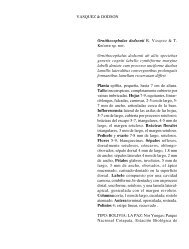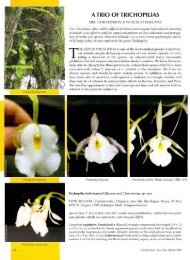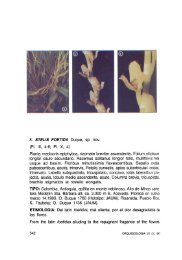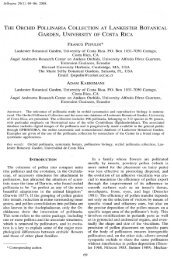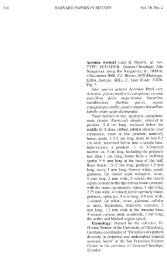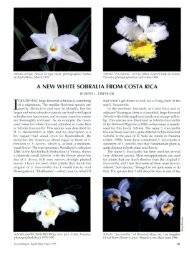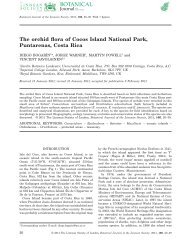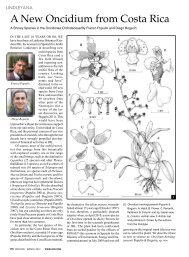Create successful ePaper yourself
Turn your PDF publications into a flip-book with our unique Google optimized e-Paper software.
Masdevallia helenae Luer, sp. nov.<br />
Planta parva epiphytica caespitosa, caulibus secundariis brevibus unifoliatis,<br />
folio coriaceo anguste obovato pedunculo paulo longiore, bractea floris<br />
atropunctata, sepalis nitidis aureis rubrovittatis in tuba cylindrica alte connatis<br />
caudis virescentibus fere aequilongis, petalis oblongis truncatis basi<br />
unguiculatis cum dente crasso grandi, labello oblongoligulato.<br />
Plant small, epiphytic, caespitose; roots slender, flexuous. Secondary<br />
stems blackish, short, terete, 1-2 cm long, concealed by 1-2 loose, tubular<br />
sheaths. Leaf erect, coriaceous, narrowly obovate, 6-9 cm long, 12-18 mm<br />
wide, the obtuse to rounded apex tridenticulate, gradually narrowed below<br />
into an indistinct, channeled petiole 2-3 cm long. Inflorescence a single,<br />
colorful flower borne by an erect, slender peduncle 4-5 cm long, from a node
on the secondary stem; floral bract tubular, 5-6 mm long, green, dotted with<br />
black; pedicel 6-18 mm long; ovary green, smooth, 7-8 mm long; sepals<br />
shiny, glabrous, light yellow-green at the base to yellow-orange above, the<br />
lateral sepals becoming white toward the apices, each sepal with 3 red stripes<br />
and a yellow-green tail, the dorsal sepal obovate, 14 mm long, 6 mm wide,<br />
connate to the lateral sepals for 9 mm into a sepaline tUbe, the triangular<br />
free portion produced into a thick tail 18 mm long, the lateral sepals obliquely<br />
oblong, 15 mm long, 5 mm wide, connate for 8 mm to form a shallow<br />
mentum, the free portions ovate, the subactue apices produced into tails<br />
similar to that of the dorsal sepal; petals white, marked with purple, oblong,<br />
6 mm long, 2.5 mm wide, the truncate apex obscurely trilobed, with a thick<br />
carina along the lower margin terminating in a large, obtuse, incurved and<br />
retrorse process just above the unguiculate base; lip red-orange marked with<br />
red, oblong-ligulate, 6 mm long, 2.5 mm wide, the subacute apex yellow, the<br />
disc broadly and shallowly canaliculate between a pair of low, rounded, longitudinal<br />
calli along either side, the shallowly cordate base hinged beneath to<br />
the column-foot; column white, edged in purple, semiterete, 6 mm long, the<br />
foot 3 mm long with a long, slender, incurved extension.<br />
ETYMOLOGY: Named in honor of Helen Kuhn of Easton, Ct., who discovered<br />
this species.<br />
TYPE: BOLIVIA: SANTA CRUZ: without locality, collected by Helen Kuhn,<br />
Aug. 1976, cultivated by J & L Orchids, Easton, Ct., flowered in cult. 4<br />
March 1978, C. Luer 2784 (HOLOTYPE: SEL).<br />
DISTRIBUTION: Bolivia.<br />
Vegetatively inseparable from numerous allied species, the shiny, colorful,<br />
tubular flower of Masdeuallia helenae is distinctive. The basic color of<br />
yellow-orange merging to white on the free portions of the lateral sepals is<br />
striped in red, and the thick, diverging tails are green to yellow. The oblong<br />
petals are provided with a thick, incurved, posteriorly directed appendage at<br />
the lower base. The simple, ligulate lip is longitudinally sulcate between low,<br />
rounded calli.




